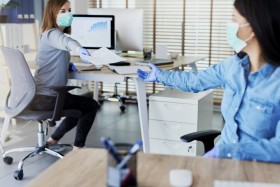Employer Obligations in the Post-Pandemic Workplace

Employers have a responsibility to provide a reasonably safe environment for their employees to work in and that is something that will remain true as we continue to move past the coronavirus pandemic. Many types of Michigan businesses have already been able to reopen and others are preparing to reopen in the near future.
At a time like this, workplace safety is more important than ever as we work to avoid a second wave of the outbreak. The pandemic has altered our lives in many different ways and as people return to work, they might be returning to a workplace that looks at least slightly different than it used to. Many employers have been closely watching the pandemic and wondering about what they can do to help reduce the risk of spreading the virus when they are able to resume normal operations again. While things like providing hand sanitizer or hand washing stations and asking people to wear masks are great starting points, what else can be done?
A key part of creating a safe workplace post-coronavirus is to do a hazard evaluation of your workplace to identify where people would be at an increased risk of contracting the virus. Also consider which types of activities might increase the risk. When dealing with something as contagious as COVID-19, it’s important to take a close look for hazards that might not necessarily be considered risky under normal circumstances. You should think about how employees do their jobs, the things they do throughout the day, and how they interact with the workplace.
Different types of workplaces have different needs, but some types of spaces to focus on are workstations, conference rooms, cafeterias, break rooms, kitchen areas, office lounges, and other common areas or spaces intended for collaboration.
Once you’ve identified those high-risk environments and activities, you need to think about what can be done to reduce the risk. For example, meetings in a conference room might have been a routine part of peoples’ time at work before the pandemic. But as offices begin to reopen, it may be best to consider a protocol for virtual meetings instead to prevent people from gathering in one place. You may need to rearrange workstations to improve social distancing or consider placing partitions around workstations to prevent the spread of illnesses.
It’s also important to think about the things that get touched frequently in the workplace, like doorknobs, refrigerators, handrails for stairs, and copy machines. What can you do to make sure those items are cleaned more frequently or touched less often? For example, an easy way to reduce touch on doorknobs would be to use doorstops to prop doors open if possible. Or if many people use a copy machine during the day, would it be practical to have one person in charge of making copies for people?
As businesses continue to reopen, keep in mind that some special accommodations may be necessary for employees with medical conditions that put them at a higher risk for serious complications if they were to contract COVID-19. In a situation like this, it’s important to offer reasonable accommodations that will allow them to work safely without being discriminatory. Some examples of this can include providing additional protective equipment, relocating a desk to be further away from other workstations, or allowing the employee to work a modified schedule so that they will be in the workplace when fewer people are in.
While some jobs can be riskier than others, it’s not acceptable for workplaces to be unnecessarily dangerous. At Goodwin & Scieszka, our unsafe workplace lawyers have helped many people who have been injured or developed illnesses while on the job. If you’ve been injured at work, contact us to find out how we can help with your case.
Image: iStock / gpointstudio






